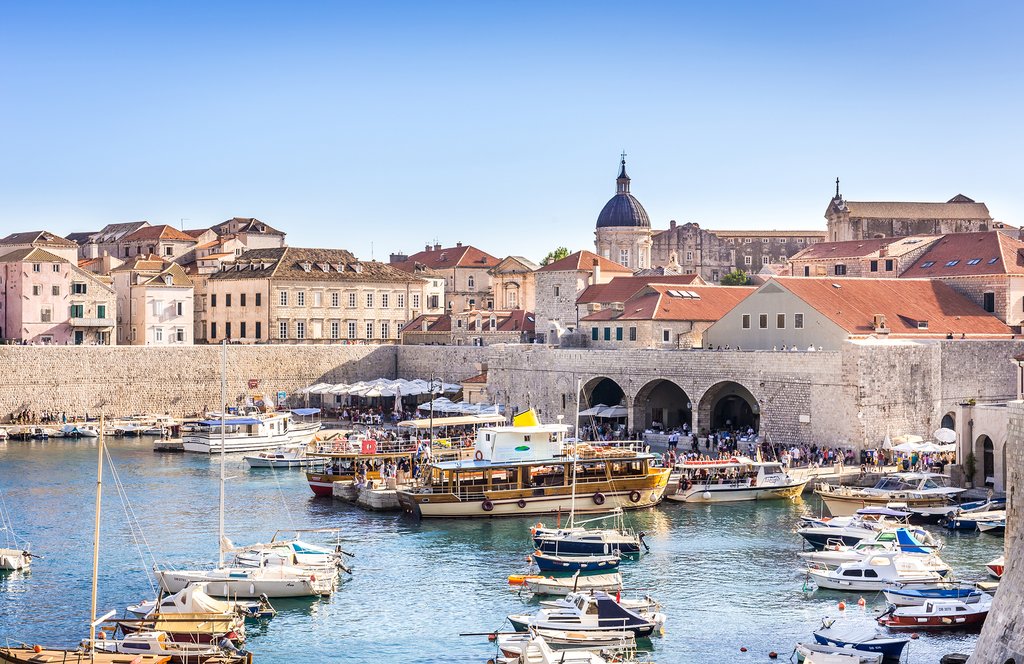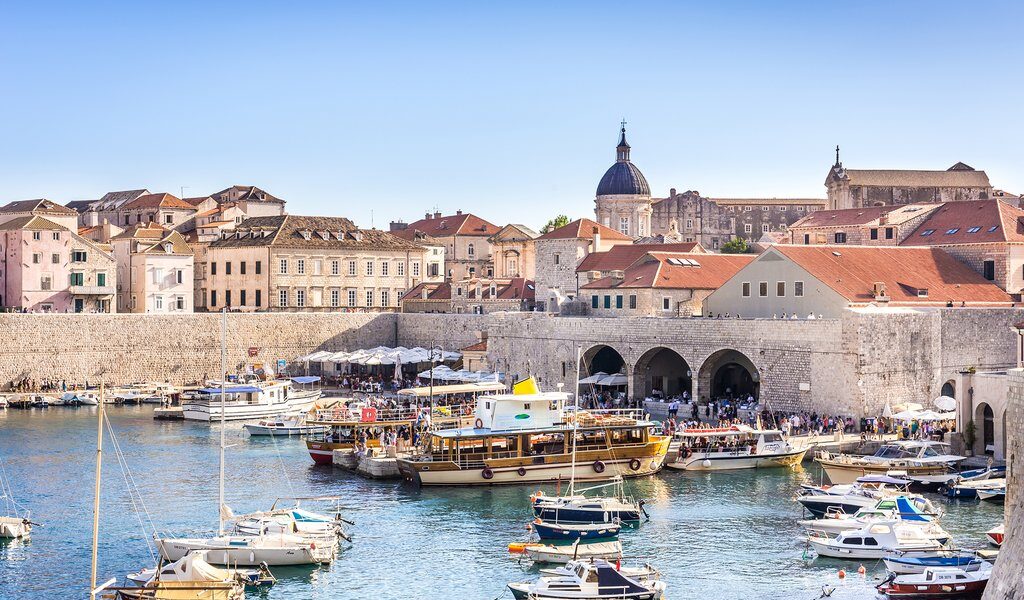
With over 3,000 miles of coastline, geography that ranges from mountains to beaches, culturally rich cities to tucked-away villages, and multiple languages and identities, Croatia can feel like ten countries in one. If you’re planning a trip to this multi-layered destination, read on to have all your questions answered—including how to get around, what to eat, how much to tip, and more.
## Unveiling the Charms of Croatia: A Comprehensive Guide
Croatia, a jewel nestled in the heart of Europe, often appears diminutive when juxtaposed with titans like France, Italy, Germany, and Spain. While the country’s geographical footprint clocks in at just over 20,000 square miles, its essence is anything but small. Its borders encompass a rich tapestry of diverse landscapes, a captivating blend of cultures, and a vibrant, layered history. Traveling from one town to another, or journeying across different regions, is akin to embarking on a series of miniature international adventures, all within a single day. The experience is akin to stepping into different worlds, each with its unique character and charm.
## Charting Your Course to Croatia: Arrival Strategies
For those eager to explore Croatia, air travel emerges as the most efficient and convenient mode of transportation. Direct flights connect numerous cities across the globe to major Croatian hubs. These bustling gateways include Zagreb, the nation’s capital, along with the dynamic urban centers of Split and Dubrovnik. Furthermore, Zadar and Pula, both located on the picturesque Istrian peninsula, also serve as prominent entry points.
Until recently, direct flights from the United States were conspicuously absent. However, this is set to change, with American Airlines inaugurating direct flights from Philadelphia International Airport (PHL) to Dubrovnik during the summer of 2019. For travelers originating from other US cities, particularly those along the east coast, a layover in a major European city, such as Munich, Frankfurt, Vienna, or Madrid, is typically required.
Unlike some European destinations that boast a central, easily accessible hub for exploring the entire country, Croatia presents a different scenario. There isn’t a single, dominant travel hub from which every corner of Croatia can be conveniently accessed. Therefore, upon arrival on Croatian soil, it may be prudent to consider booking domestic flights with Croatian Airlines to facilitate travel between key destinations. For instance, flights from Zagreb to Split or Split to Dubrovnik can save considerable time. However, don’t dismiss the allure of overland travel. The journeys themselves are breathtakingly scenic, and the distances between destinations are often quite manageable, making for a rewarding travel experience.
## A Culinary Journey Through Croatia: A Symphony of Flavors
Croatia’s rich and complex history, having been a part of numerous empires, kingdoms, and countries, has resulted in a diverse and eclectic culinary landscape. The food scene is a reflection of the nation’s multifaceted past, offering something to suit every palate. In the northern regions, you’ll discover cuisine that bears a striking resemblance to Eastern European fare. Hearty dishes featuring meat and potatoes take center stage, complemented by an array of root vegetables and cabbage-based sides.
Venturing into Istria, a region formerly under Venetian influence, you’ll encounter culinary creations that evoke the flavors of Italy. Pastas and rich soups abound, but with distinctive Croatian twists. The dishes are familiar yet unique, a testament to the region’s blended heritage.
Along the coast, the focus shifts to the bounty of the sea. Dalmatia, in particular, celebrates fresh, daily catches. Grilled whole fish, succulent seafood, and vibrant greens are prepared simply with garlic, fragrant herbs, and luscious olive oil, embodying the essence of Mediterranean cuisine.
To truly immerse yourself in Croatian gastronomy, be sure to sample some of the country’s signature dishes. *Crni Rizot*, a sumptuous black seafood risotto made with squid ink, is a must-try. *Strukli*, a delectable pastry filled with cheese curds and cream, will resonate with anyone who appreciates Russian food. *Skampi na Buzaru* showcases shrimp prepared in a traditional Croatian style: simmered in a rich sauce of tomato, garlic, and wine. Finally, *Istarski fuzu*, a distinctive type of folded, arrow-shaped pasta, is a specialty of the Istrian peninsula. Even seasoned pasta aficionados who have explored Italy will find this dish a revelation, as it is exclusive to this region.
Similar to Italy and Spain, Croatians traditionally observed a leisurely lunch break as the primary meal of the day. While this custom is gradually fading as more locals adopt 9-to-5 work schedules, weekends still see families gathering around expansive tables laden with culinary delights, celebrating the bounty of the land and the bonds of togetherness. If you are fortunate enough to forge a connection with a local, you might even receive an invitation to partake in a home-cooked feast.
## Visa Requirements: Navigating Entry into Croatia
As a member of the European Union, Croatia extends visa-free entry to citizens of the United States, the United Kingdom, Canada, Australia, and New Zealand. These passport holders are permitted to stay in the country for up to 90 days, provided they possess a valid passport.
## Safety Considerations: Ensuring a Secure Journey in Croatia
Croatia is widely recognized as a safe and welcoming destination for travelers. There are no specific travel restrictions, aside from the standard requirement that passport holders have at least three months of validity remaining on their passports.
However, a lingering concern stems from the presence of landmines, remnants of the Balkan Wars. An estimated million mines remain, many of which have yet to be discovered and deactivated in remote areas. When venturing into the countryside, it is crucial to adhere to marked paths and avoid venturing into rough or uncharted terrain. Rest assured, all areas frequented by tourists have undergone thorough de-mining efforts.
## Family Adventures: Creating Memorable Experiences in Croatia
Croatia’s friendly and relaxed atmosphere makes it an ideal destination for families. Numerous activities cater to a wide range of interests and age groups. To captivate the attention of inquisitive and energetic children, consider prioritizing experiences that allow them to explore and roam freely, steering clear of traditional museums. A visit to Plitvice Lakes National Park (provided the children are old enough to navigate the walkways independently) is an excellent option. Alternatively, a boat trip along the Dalmatian Coast, with stops at various islands for swimming, snorkeling, scuba diving, and general beach relaxation, promises a memorable experience. Walking along the walls surrounding Dubrovnik’s old town is also a great adventure for children.
The growth of tourism in Croatia has led to an increase in family-friendly accommodation options. These include traditional room and board provided by local families in their homes (offering an immersive cultural experience for older children), as well as guesthouses and apartment hotels equipped with kitchens and living spaces.
## Duration of Stay: Crafting Your Ideal Croatian Itinerary
The ideal duration of your Croatian adventure depends entirely on your individual preferences, objectives, and available time. Even if you only have a long weekend to spare, a trip to Croatia is still worthwhile. It provides a glimpse into the country’s allure, allowing you to discover what resonates with you and inspire plans for a longer, more in-depth exploration in the future (and we are sure you’ll want to!).
If you have a week at your disposal, focus on a specific region, such as Dalmatia, Istria, or Slavonia. Establish a home base in one or two cities or towns and explore the surrounding natural wonders. For those with more than a week to spare, consider utilizing bus or train travel to connect different regions, or rent a car and embark on a leisurely road trip. Dubrovnik, Pula, Zadar on the Istrian peninsula and Plitvice Lakes National Park exemplify single destinations to prioritize if your time is limited.
## Language Barrier: Navigating Croatia as an Independent Traveler
Even without fluency in Croatian, independent travel is entirely feasible. Given the limited global reach of the Croatian language and the growing prominence of tourism as a key industry, a significant percentage of Croatians – around 80% – are multilingual. In addition to Croatian, many also speak English, Italian, German, and Spanish. Almost all hotel websites in Croatia offer an English language version, and most restaurants provide menus in English.
## Currency Matters: Understanding the Croatian Kuna
Despite being part of the European Union, Croatia retains its own currency, the *Kuna*. At the time of writing, the exchange rate is approximately 6.5 HRK or *Hrvatska Kuna* per dollar.
## Cost of Travel: Budgeting for Your Croatian Adventure
Croatia has long been recognized as one of Europe’s more affordable destinations. However, its rising popularity has led to an increase in prices. Nevertheless, compared to Western European countries, Croatia remains a bargain. Expect to pay between $70 and $130 per night for mid-range hotel accommodations. Dining at a mid-range restaurant typically costs around $15 to $20 per person.
To further economize, embrace the local lifestyle by shopping at weekly markets. Even without kitchen facilities, you can assemble a delightful meal of breads, cheeses, and fresh fruits and vegetables – perfect for picnics during hikes and boat excursions.
Consider traveling outside of Croatia’s peak season to save on accommodation costs. During the off-season, there are fewer tourists, and the ports are less crowded with cruise ship passengers. Even in May, the weather is often pleasant (though the sea might still be cool), and you can secure hotel rooms and guesthouse accommodations at lower prices.
## Credit Card Acceptance: Navigating Payment Options in Croatia
Credit cards are widely accepted at hotels and most restaurants. However, you may encounter difficulties in smaller towns or when staying in private accommodations. It is advisable to carry cash and, if possible, more than one credit card, as some establishments may have preferred cards. When paying with a credit card in Croatia, ensure you are billed in Croatian kuna (rather than your home currency) to avoid additional fees.
## Tipping Etiquette: Showing Appreciation in Croatia
Given the comparatively low wages in Croatia, tipping is customary and appreciated. Hotel staff should be tipped as is customary in other countries. Leave a tip for the daily maid and the concierge if they have provided exceptional service, such as booking tours or securing coveted dinner reservations. A tip of around 10% is customary in restaurants, with a higher amount for outstanding service.
For tour guides, a tip of 10-15 HRK for day tours is appreciated, with more expected for multi-day tours or guides who also serve as drivers. Taxi drivers in Croatia do not typically expect tips, although rounding up by a few *Kuna* is a nice gesture if the driver provides helpful recommendations or insider tips. Shuttle and bus drivers do not expect tips.
## Packing Essentials: Preparing for Your Croatian Journey
Unless you have plans to dine at upscale restaurants, attend a formal conference or event, or enjoy a special night out, there is little need to pack formal attire. Most of your time will be spent exploring cities, traversing the countryside, or enjoying the scenery from a boat.
Pack breathable clothing, comfortable walking shoes or sandals, and swimwear (if traveling during the warmer months). Croatians embrace color, so leave your neutral-toned clothing at home and bring out your brightest and most cheerful pieces. Don’t forget sunglasses and sunblock. While the colder months in Croatia’s interior can bring freezing temperatures, the coast rarely drops below 5°C/41°F. In essence, pack layers for winter along the coast and snow-appropriate outerwear for inland winters.
## Electrical Adapters and Converters: Staying Connected in Croatia
Croatia operates on 230V 50Hz and utilizes the standard two-pronged European plug, which is prevalent throughout the continent. If you already have an adapter compatible with this type of plug, you will not need to purchase a new one.
## Vaccinations: Ensuring a Healthy Trip to Croatia
The Centers for Disease Control and Prevention (CDC) recommends that all travelers be up to date on routine vaccinations. No additional vaccinations are required for travel to Croatia.

